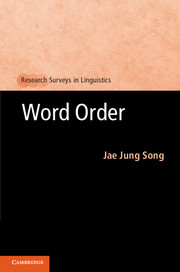Book contents
4 - The generative approach
stipulation or deduction
Published online by Cambridge University Press: 05 June 2012
Summary
This chapter discusses how word order is conceptualized and theorized within Generative Grammar (GG), as defined in Chapter 3. It should be reiterated that within GG, the term ‘word order’ is infrequently used. Far more commonly used is ‘linear order’ or, abstractly, ‘linearization’ – the latter implying that formal representations, initially void of linear order, undergo an operation in order to assume particular linear-order properties. This labelling convention in GG will be adopted for purposes of this chapter. Readers unfamiliar (or vaguely familiar) with GG are advised to read Chapter 3 first, which will provide an overview of the historical and conceptual background of GG, deemed necessary to understand better the word-order research in GG.
The rest of the chapter is organized as follows. In §4.1, the role and status of linear order or linearization in GG, initially from the pre-Minimalist perspective and then from the Minimalist perspective, are briefly outlined as a backdrop for the main discussion that ensues. The focus of the chapter shifts in §4.2 and §4.3 to the way in which linear order, or linearization, has been handled within the context of GG. Discussed there is how linear order has been conceptualized in GG, initially as something stipulated in grammar and then as something deduced from modules or sub-theories of grammar (§4.2), or from some fundamental structural or configurational properties (§4.3). The latter theorizing of linearization, as most prominent in Kayne (1994), is also examined in §4.4, in conjunction with Cinque (1996, 2000, 2005), in the light of cross-linguistic (or Greenbergian) data. In §4.5, Kayne’s theory of linearization, which is based crucially on asymmetric c-command, is re-evaluated in the light of more recent developments in GG, namely the Minimalist Program. Also discussed in that section are different minimalist, albeit programmatic, attempts to reduce Kayne’s theory to the unadulterated concept of asymmetric c-command, or even to replace asymmetric c-command itself with a more fundamental syntactic operation, that is, Merge. The chapter comes to a close in §4.6, with concluding remarks.
- Type
- Chapter
- Information
- Word Order , pp. 99 - 159Publisher: Cambridge University PressPrint publication year: 2012

